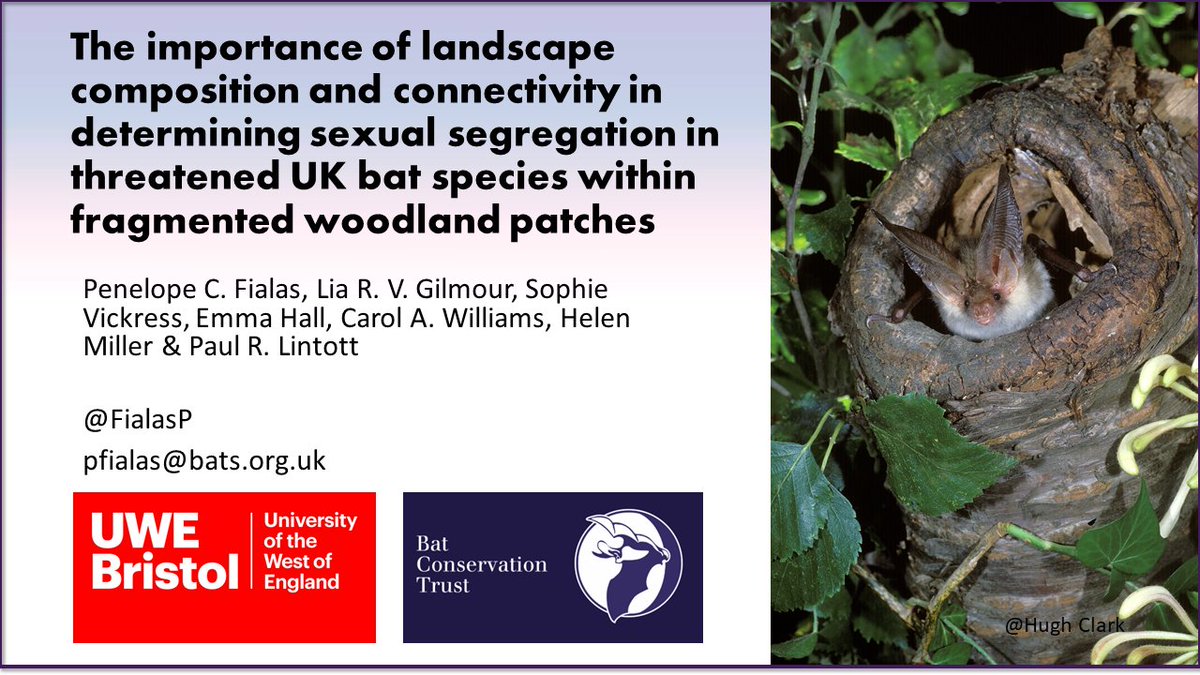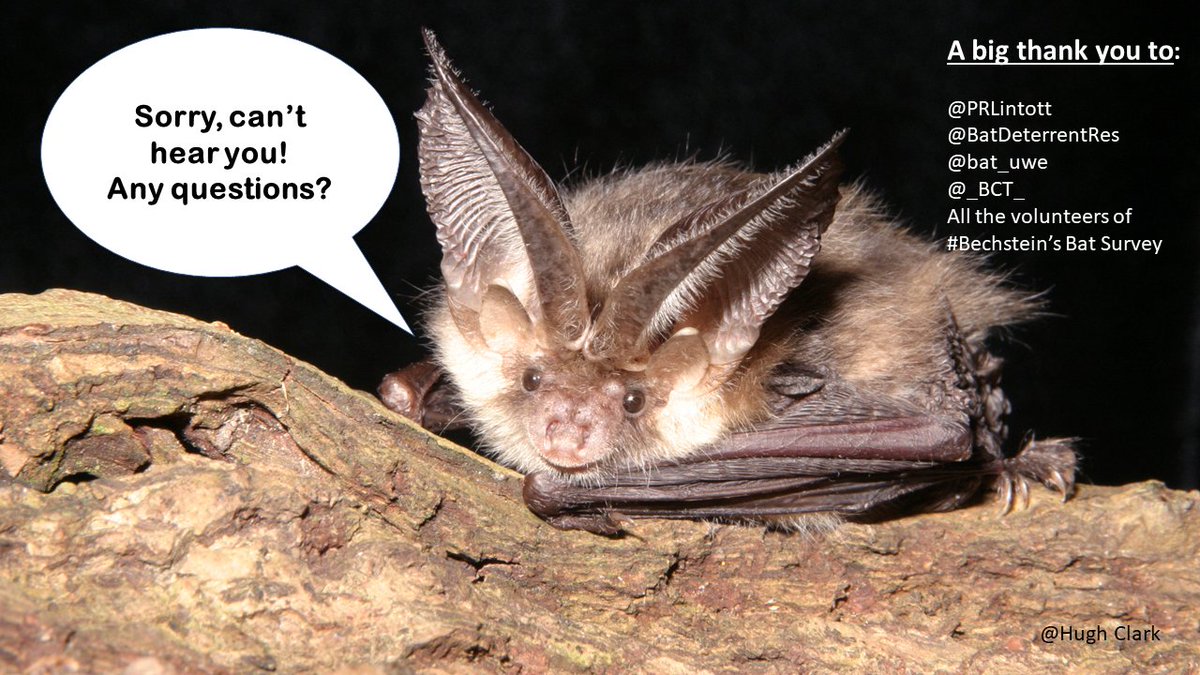1/5 #WBTC1 #BatLand1 Agricultural expansion & the resultant fragmentation of habitats has led to  https://abs.twimg.com/emoji/v2/... draggable="false" alt="🌎" title="Earth globe americas" aria-label="Emoji: Earth globe americas"> declines in biodiversity, but how male & females
https://abs.twimg.com/emoji/v2/... draggable="false" alt="🌎" title="Earth globe americas" aria-label="Emoji: Earth globe americas"> declines in biodiversity, but how male & females  https://abs.twimg.com/emoji/v2/... draggable="false" alt="🦇" title="Bat" aria-label="Emoji: Bat"> respond to landscape fragmentation?
https://abs.twimg.com/emoji/v2/... draggable="false" alt="🦇" title="Bat" aria-label="Emoji: Bat"> respond to landscape fragmentation?
We assessed sex differences in the use of fragmented woodlands using #CitizenScience data
We assessed sex differences in the use of fragmented woodlands using #CitizenScience data
2/5 #WBTC1 #BatLand1 We analysed https://abs.twimg.com/emoji/v2/... draggable="false" alt="🦇" title="Bat" aria-label="Emoji: Bat">capture data collected in 206 woodlands over 3yrs by volunteers @_BCT_ #BechsteinSurvey.
https://abs.twimg.com/emoji/v2/... draggable="false" alt="🦇" title="Bat" aria-label="Emoji: Bat">capture data collected in 206 woodlands over 3yrs by volunteers @_BCT_ #BechsteinSurvey.
We created 6 buffers around each site and reclassified #LCM2007 @UK_CEH to calculate various landscape metrics using #Fragstats. We performed #glmm @rstudio
We created 6 buffers around each site and reclassified #LCM2007 @UK_CEH to calculate various landscape metrics using #Fragstats. We performed #glmm @rstudio
3/5 #WBTC1 #BatLand1 Total: 873  https://abs.twimg.com/emoji/v2/... draggable="false" alt="🦇" title="Bat" aria-label="Emoji: Bat"> were captured,
https://abs.twimg.com/emoji/v2/... draggable="false" alt="🦇" title="Bat" aria-label="Emoji: Bat"> were captured,  https://abs.twimg.com/emoji/v2/... draggable="false" alt="♀️" title="Female sign" aria-label="Emoji: Female sign"> represented 40% of all captures, with P.auritus as the dominant sp. (41% of all
https://abs.twimg.com/emoji/v2/... draggable="false" alt="♀️" title="Female sign" aria-label="Emoji: Female sign"> represented 40% of all captures, with P.auritus as the dominant sp. (41% of all  https://abs.twimg.com/emoji/v2/... draggable="false" alt="🦇" title="Bat" aria-label="Emoji: Bat">caught). We found sex differences in habitat use only in 3 spp. - P. auritus, M. nattereri and M. mystacinus and were species- specific
https://abs.twimg.com/emoji/v2/... draggable="false" alt="🦇" title="Bat" aria-label="Emoji: Bat">caught). We found sex differences in habitat use only in 3 spp. - P. auritus, M. nattereri and M. mystacinus and were species- specific
4/5 #WBTC1 #BatLand1 The study highlights that  https://abs.twimg.com/emoji/v2/... draggable="false" alt="♂️" title="Male sign" aria-label="Emoji: Male sign">&
https://abs.twimg.com/emoji/v2/... draggable="false" alt="♂️" title="Male sign" aria-label="Emoji: Male sign">&  https://abs.twimg.com/emoji/v2/... draggable="false" alt="♀️" title="Female sign" aria-label="Emoji: Female sign">
https://abs.twimg.com/emoji/v2/... draggable="false" alt="♀️" title="Female sign" aria-label="Emoji: Female sign"> https://abs.twimg.com/emoji/v2/... draggable="false" alt="🦇" title="Bat" aria-label="Emoji: Bat"> respond differently to fragmented woodland landscapes.
https://abs.twimg.com/emoji/v2/... draggable="false" alt="🦇" title="Bat" aria-label="Emoji: Bat"> respond differently to fragmented woodland landscapes. https://abs.twimg.com/emoji/v2/... draggable="false" alt="♀️" title="Female sign" aria-label="Emoji: Female sign"> mammals often have higher energy requirements than
https://abs.twimg.com/emoji/v2/... draggable="false" alt="♀️" title="Female sign" aria-label="Emoji: Female sign"> mammals often have higher energy requirements than  https://abs.twimg.com/emoji/v2/... draggable="false" alt="♂️" title="Male sign" aria-label="Emoji: Male sign">, due to the demands of rearing young and thus are often found in higher quality habitats to meet those demands
https://abs.twimg.com/emoji/v2/... draggable="false" alt="♂️" title="Male sign" aria-label="Emoji: Male sign">, due to the demands of rearing young and thus are often found in higher quality habitats to meet those demands
5/5 #WBTC1 #BatLand1 We found more  https://abs.twimg.com/emoji/v2/... draggable="false" alt="♀️" title="Female sign" aria-label="Emoji: Female sign">
https://abs.twimg.com/emoji/v2/... draggable="false" alt="♀️" title="Female sign" aria-label="Emoji: Female sign"> https://abs.twimg.com/emoji/v2/... draggable="false" alt="🦇" title="Bat" aria-label="Emoji: Bat"> in poorly connected woodlands surrounded by #agricultural landscapes, demonstrating the importance of isolated remnant woodland and associated surrounding #habitats in highly fragmented rural environments.
https://abs.twimg.com/emoji/v2/... draggable="false" alt="🦇" title="Bat" aria-label="Emoji: Bat"> in poorly connected woodlands surrounded by #agricultural landscapes, demonstrating the importance of isolated remnant woodland and associated surrounding #habitats in highly fragmented rural environments.
Protect Enhance Create> #woodlands
Protect Enhance Create> #woodlands

 Read on Twitter
Read on Twitter declines in biodiversity, but how male & females https://abs.twimg.com/emoji/v2/... draggable="false" alt="🦇" title="Bat" aria-label="Emoji: Bat"> respond to landscape fragmentation? We assessed sex differences in the use of fragmented woodlands using #CitizenScience data" title="1/5 #WBTC1 #BatLand1 Agricultural expansion & the resultant fragmentation of habitats has led to https://abs.twimg.com/emoji/v2/... draggable="false" alt="🌎" title="Earth globe americas" aria-label="Emoji: Earth globe americas"> declines in biodiversity, but how male & females https://abs.twimg.com/emoji/v2/... draggable="false" alt="🦇" title="Bat" aria-label="Emoji: Bat"> respond to landscape fragmentation? We assessed sex differences in the use of fragmented woodlands using #CitizenScience data" class="img-responsive" style="max-width:100%;"/>
declines in biodiversity, but how male & females https://abs.twimg.com/emoji/v2/... draggable="false" alt="🦇" title="Bat" aria-label="Emoji: Bat"> respond to landscape fragmentation? We assessed sex differences in the use of fragmented woodlands using #CitizenScience data" title="1/5 #WBTC1 #BatLand1 Agricultural expansion & the resultant fragmentation of habitats has led to https://abs.twimg.com/emoji/v2/... draggable="false" alt="🌎" title="Earth globe americas" aria-label="Emoji: Earth globe americas"> declines in biodiversity, but how male & females https://abs.twimg.com/emoji/v2/... draggable="false" alt="🦇" title="Bat" aria-label="Emoji: Bat"> respond to landscape fragmentation? We assessed sex differences in the use of fragmented woodlands using #CitizenScience data" class="img-responsive" style="max-width:100%;"/>
 https://abs.twimg.com/emoji/v2/... draggable="false" alt="🦇" title="Bat" aria-label="Emoji: Bat"> in poorly connected woodlands surrounded by #agricultural landscapes, demonstrating the importance of isolated remnant woodland and associated surrounding #habitats in highly fragmented rural environments.Protect Enhance Create> #woodlands" title="5/5 #WBTC1 #BatLand1 We found more https://abs.twimg.com/emoji/v2/... draggable="false" alt="♀️" title="Female sign" aria-label="Emoji: Female sign">https://abs.twimg.com/emoji/v2/... draggable="false" alt="🦇" title="Bat" aria-label="Emoji: Bat"> in poorly connected woodlands surrounded by #agricultural landscapes, demonstrating the importance of isolated remnant woodland and associated surrounding #habitats in highly fragmented rural environments.Protect Enhance Create> #woodlands" class="img-responsive" style="max-width:100%;"/>
https://abs.twimg.com/emoji/v2/... draggable="false" alt="🦇" title="Bat" aria-label="Emoji: Bat"> in poorly connected woodlands surrounded by #agricultural landscapes, demonstrating the importance of isolated remnant woodland and associated surrounding #habitats in highly fragmented rural environments.Protect Enhance Create> #woodlands" title="5/5 #WBTC1 #BatLand1 We found more https://abs.twimg.com/emoji/v2/... draggable="false" alt="♀️" title="Female sign" aria-label="Emoji: Female sign">https://abs.twimg.com/emoji/v2/... draggable="false" alt="🦇" title="Bat" aria-label="Emoji: Bat"> in poorly connected woodlands surrounded by #agricultural landscapes, demonstrating the importance of isolated remnant woodland and associated surrounding #habitats in highly fragmented rural environments.Protect Enhance Create> #woodlands" class="img-responsive" style="max-width:100%;"/>


